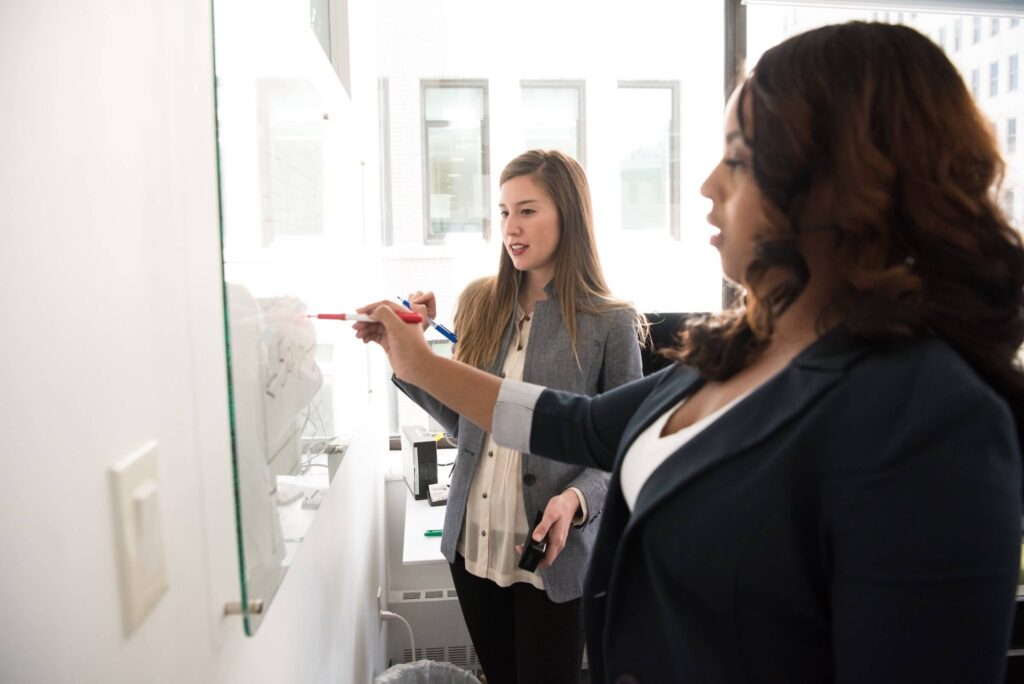How Haidee Thanda & Andrew Barrett Introduced PlusPlus and Peer-to-Peer Learning at Shopify
Introducing a new technology or piece of software across a large company is a difficult endeavor. Complexity increases when the company is experiencing hyper-growth and exploring new approaches to promote learning at scale This is exactly the challenge that Haidee Thanda, Learning Platform Architect, and Andrew Barrett, Learning Platform Lead, are tackling at Shopify.
Step one: find the right tool
Haidee and Andrew first recognized a need when a Shopify engineer built a tool during an internal hackathon. This tool was used to help people connect with and learn from each other around various topics. The only problem was that it wasn’t a self-sustaining project. It needed a full-time engineer to maintain the tool, which wasn’t a possibility at the time. Around the same time, another engineer had built a learning portal — a place where engineers could sign up for training courses or events. But again — this tool needed a clear owner and maintainer going forward.
Andrew realized that in order for a peer-to-peer learning tool to be impactful at Shopify, it needed a product management lens to ensure that the UX was up to Shopify standards and that it met the actual needs of the engineers.
“Building learning technology products are not our forte, so it’s important that we maintain our focus on our own product,” says Andrew. “We’ve learned over the years that if there’s a key need, there’s likely a tool out there that can meet that need. We may not have absolute control over everything — perhaps we would change how it looks, or it might not function exactly how we’d prefer, but that’s a fair trade-off. If you can build a good relationship with the vendor as we have with PlusPlus, you can nudge things in a certain direction and offer crucial feedback. We’re not a magical snowflake that has completely different needs than other tech companies; these are common problems even at companies like Google and Apple.”
By finding a tool that fits the need rather than taking on the responsibility of building a new one, Shopify has been able to focus on the more important piece: working with early adopters to gain approval and increase exposure throughout the company.
Step two: follow the demand
By primarily focusing on the early adopters, Haidee and Andrew have been able to find the Shopify employees who are most enthusiastic about PlusPlus and form a program around their specific needs.
“We’ve been able to work with these early adopters who are clamoring for the tool,” says Andrew. “Through their excitement, other teams are learning about the tool and seeing potential needs in their department, which is spurring the demand. We’re not pushing it on them. Instead, we’re being pulled in to help them when they find a problem that we might be a good solution for. Whether it’s a team or a new initiative or someone wanting to form a mentorship program, people are finding all sorts of use cases and we’re more than happy to help.”
“Requests are rolling in at a pace where we can provide high care and high support to make sure that the experience is really good for each team,” adds Haidee. “Keeping the program small has allowed us to figure out what some of the common gaps are throughout the company and begin to address those on a small scale rather than tackling everything at once.”
Starting small and working out the details with the early adopters allows the Learning team to make sure they’re meeting the needs of their engineers and non-engineers as well as the stakeholders prior to rolling something out company-wide. Given that the integration of a learning technology like PlusPlus also comes with a larger acceptance of the concept of peer-to-peer learning, having a series of small wins with a variety of teams can lead to a much broader success rate throughout the company. These early adopters become internal ambassadors for the tool, which drives demand as well as an acceptance of the overarching principle.
Step three: lower the barriers
We’ve established that peer-to-peer learning is an effective practice for many companies. But at Shopify, knowledge sharing was happening among the engineering teams even without a formal tool in place. Adding a tooling structure like PlusPlus on top of the unofficial lunch-and-learns and spontaneous training sessions that were happening over Slack was simply giving more assistance to an already-eager engineering staff to find, set up and share a learning event.
Haidee’s goal for this new program is simple: “We want to help what’s already happening organically by reducing the barriers. By providing teaching and facilitation training to our employees we are making it easier for our employees to share their tribal knowledge with others. This increases their personal impact because they can help others grow. Engineers aren’t just sharing knowledge about various tools; they’re sharing what they know from their time at Shopify from within their specific context and their specific roles. This is where the real value comes into play — this internal knowledge transfer is essential to the success and retention of Shopify engineers.”
Additionally, as Haidee and Andrew have been rolling out this new program, they’ve also tracked a variety of data points. From what topics people are interested in, to which departments the demand is coming from, to which sessions were most successful, all of the data they’ve collected has led to a tremendous amount of information about what is interesting and insightful to the Shopify employee-base. These internal training programs have not only led to a great deal of knowledge transfer but the ability to reach business goals with data-driven decisions about the topics that are most interesting and useful to the Shopify engineers.
By allowing their engineers to focus on what they’re best at — building the Shopify product — and opening up the opportunity for engineers to host a variety of learning experiences, Shopify has found a sweet spot that meets the needs of their employees as well as the company.







